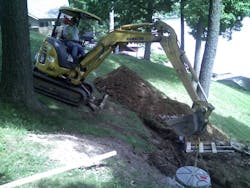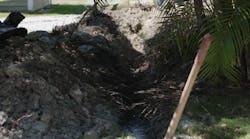About the author:
Joseph Harmes is a freelance writer. Harmes can be reached at [email protected].
Septic systems galvanize Florida's environmental discourse.
When “Doonesbury” satirized U.S. Sen. Marco Rubio’s views on climate change with the factoid of a “million-plus septic tanks at risk of failing,” few Floridians took notice.
Until recently, the subterranean collection method for raw sewage remained out of sight and out of mind—except for those directly affected. However, millions bore witness in 2017 when Hurricane Irma flooded towns and cities with raw sewage as septic systems overflowed. In 2018, nitrogen creeping from leaking septic tanks helped spawn a red tide hugging much of Florida’s coastlines and generated unprecedented algae blooms in streams, lakes and canals, turning the water murky, killing coral and threatening marine species and food chains with toxins from huge numbers of plankton.
Unexpectedly, Florida’s politicians and the newly elected governor began 2019 focusing on water-related problems, its 2.6 million septic systems—12% of the nation’s total—in particular. In January, a Senate subcommittee heard testimony from Dr. Brian E. Lapointe, a research professor at Florida Atlantic University, who designated septic tanks “the most important and urgent issue facing our state” and called for “a Manhattan Project” to “go to war against algae.”
The exact number of septic systems in the U.S. is unknown but growing. The U.S. Census Bureau says approximately 23% of the country’s estimated 115 million occupied homes depend on septic systems. According to the U.S. EPA, more than one in five households utilize onsite sewage treatment and disposal systems, such as septic, cesspits, latrines and straight pipes.
Septic techniques arrived from France in 1884 and, given their low initial cost, quickly became the country’s predominant method of sewage treatment and disposal. Post-World War II, septic was embraced by developers racing to erect affordable housing for returning servicemen. It flourished again to accommodate the Baby Boom suburbs of the 1950s and ’60s. Others still in operation are far older.
“Mine was one large redwood tank from 1934,” said Steve Halsted of Rincon Point, a beachfront enclave on California’s Pacific coast that migrated to pressure sewers in 2014 after septic tanks servicing 72 homes polluted the surfing mecca.
Backyard Wastewater Treatment
Although frequently considered a rural device limited to areas where gravity is unavailable or fiscally prohibitive, almost half of septic systems dwell in urban and suburban settings with dense concentrations in Indianapolis and Long Island, where an estimated 1 million people are on septic. Though they were originally conceived as a temporary solution until central sewer networks could be installed, few such transitions materialized.
Under optimal site conditions and regular maintenance, septic provides a safe, inexpensive and effective treatment of household wastewater for 10 to 40 years. Canada’s Halifax Regional Municipality considers them superior to traditional gravity sewers, in some cases.
Last year, Hawaii declared war on 88,000 cesspools that put 53 million gal of raw sewage into its groundwater and surface waters every day. A $10,000 tax credit is available to assist homeowners’ conversions, with septic considered a viable option.
Fabricated from concrete, fiberglass or plastic, septic tanks are designed to trap solid waste for primary treatment. Liquids are discharged through perforated pipes to a drain field to “percolate” further biological breakdowns. By design, they leak.
EPA estimates 40% of septic tanks do not function properly and have dumped hundreds of millions of gallons of raw, untreated wastewater and other toxic materials into the ground and, at times, the nation’s water supply.
“Leaking, malfunctioning and worn out septic tanks are responsible for most of the groundwater pollution in the U.S. today,” the agency said.
In areas where septic system deterioration is rampant, studies conclude the systems were poorly designed, cheaply built or improperly maintained. Millions now are decades past their expiration dates.
Constricted Lifestyles
Septic tanks are prone to failure in areas with high water tables, in coastal locales where climate change is raising seas and groundwater levels, and on top of solid rock. Near shorelines, septic leach fields are located in porous, sandy soils affected by a very high, tidally influenced groundwater. One resident said he could raise his tank’s lid and watch the tide rise inside.
In the Florida Keys, septic systems with small drain fields fronted canals, and crystalline waters turned putrid.
“Septic tanks aren’t a problem when there’s just a few. In fact, they’re very efficient,” said Mike Laudicina, a commercial fisherman in the Florida Keys. “But when you start putting them side by side in waterfront developments, there’s really nowhere for the wastewater to go.”
Southside, Ark., with 30 to 40 in. of annual rainfall, saw that septic systems on an acre of land still could not percolate and decline was rapid and inevitable. The entire town sits on high water tables near its river and only a few feet of soil above marble and granite at higher elevations.
“Being able to shower and do laundry on the same day was a problem, as was using your yard or mowing grass because of the soggy ground,” said Mark Carlson of the Southside Public Water Authority.
After septic tanks collapsed in tony Martha’s Vineyard, Mass., residents canceled dinner parties, ate off paper plates and hesitated to flush. Tiny Astor, Fla., saw its “old Florida” charm fade when rain converted drain fields into sanitary hazards and unpumped tanks flowed back into houses. Septic-related fish kills occurred nearby on the St. John’s River. Nonetheless, septic tanks persist.
“One thing that always strikes me is what people will learn to live with when they have a septic system at a cottage,” said James Rothenberger, vice president of Rothenberger Construction in Concord, Mich. “I’ve seen people having a Porta-John in the driveway for the summer because they can’t use the bathroom. Or they can’t do the dishes at the same time they take a shower. Or they can’t take a shower at all.”
Residents of Lowndes County, Ala., could live with those problems. Researchers have concluded that failing septic systems are responsible for contaminated water and parasites in the intestines of 34% of the population of the county, just west of Montgomery.
High septic-related E. coli bacteria counts have continuously sickened swimmers and closed lakes and beaches throughout the country.
However, even the best-designed system’s efficacy relies on the homeowner. Manufacturers recommend that septic tanks and fields be pumped out and inspected every one to five years, while EPA suggests one to three years. Too often, owners lapse into a flush-and-forget mentality and do not heed a problem until it is visible or odorous.
Florida’s Department of Environmental Protection reports only about 100,000 septic tanks are pumped each year, meaning more than 2 million tanks have gone unpumped for more than five years.
Gravity and pressure sewers deliver wastewater to a treatment plant, whereas septage is handled differently. The 100,000 cleaned systems generate an estimated 100 million gal of septage requiring treatment and disposal, often at a facility owned by a small business, septage hauler or local government. It alone might cost as much as a moderate wastewater treatment plant often employed by small towns or private developments. A 40,000-gal-per-day (40-homes-per-day) stand-alone treatment facility to produce biosolids meeting Class-A requirements costs about $3.6 million.
Winds of Change
No federal entity regulates septic systems. Rules are established at the state and local levels, which often are torn between implementing laws and individual responsibility. Florida hopes to pass legislation—effective in 2021 and perhaps the most comprehensive in the nation—tackling data, oversight and design. It will require identification and mapping of all systems, minimum standards for functioning systems, repair and pump-out rules for owners, and possible financing to upgrade failing tanks and drain fields.
Lawmakers can expect opposition. Municipalities attempting septic eradication inevitably encounter the same arguments: We are not polluting so why incur the cost? We are disposing waste on our own properties so we do not rely on the government. It is a new bill I will have to pay. A sewer system will open the door to growth and developers.
Septic remediation usually is instigated by a municipality or an alternative is engineered by environmentally conscious developers. Small towns such as Southside and Astor have cobbled together state and federal funds to migrate from septic to pressure sewers. The Twin Lakes Regional Sewer District in Indiana converted 5,950 locations formerly on septic to create the Western Hemisphere’s largest pressure sewer system. Outside Melbourne, Australia, 16,000 failing septic units were replaced with a “smart” pressure network.
The changeovers often spark economic development. A functional sewer lured auto dealerships to Southside. They allowed a riverside condo complex in Astor and attracted full-time residents who expanded tiny cottages formerly constrained by septic in Twin Lakes.
The developers of Seven Lakes, a conservation community outside of Halifax, chose a pressure system after concluding that septic ownership and maintenance intimidated homebuyers and jeopardized its creeks, ponds and lakes. Fairfield Glade, a retirement community and resort in Tennessee, feared its lakes could be threatened by raw sewage emanating from saturated drain fields. It has about 4,650 properties on a pressure network, with buildout estimated to reach 15,000. Developers around Austin, Texas’ Lake Travis are required to install pressure systems in lieu of septic.
After a $1 billion septic eradication program in the Florida Keys, “We see life coming back,” said George Garrett, director of planning for Marathon, Fla. “We see clarity of water we didn’t see 30 years ago. We see mammals we didn’t see 30 years ago. It’s a really, really positive thing.”
Lapointe believes the message is clear.
“We have fouled our nest, and we’ve got to do a better job in cleaning this up,” he said.
About the Author
Joseph Harmes
Joseph Harmes is an independent writer. Harmes can be reached at [email protected].




